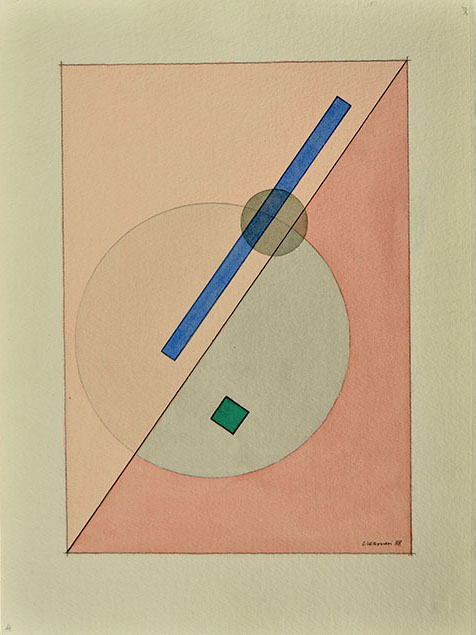(Milan 1908 - 1998)
446 - COSTRUZIONE X 3 - VARIAZIONE, 1988
Black chalk and watercolor, signed and dated bottom right L. VERONESI 88. Titled on the verso in black chalk.
To the framing line 290 x 204 mm, the full sheet measuring 380 x 290.
Luigi Veronesi began his art studies as an apprentice to Neapolitan painter, Carmelo Violante, then professor at the Accademia Carrara of Bergamo, who taught him all the secrets of the art, especially of landscape and figurative painting. The big Modigliani exhibition in 1930, where he discovered Kandinsky, Klee, Schlemmer and the Bauhaus group, unexpectedly opened his horizons towards abstraction. Four years later, Veronesi joined the Abstraction-Création group. He exhibited his sketches for Stravinsky's Le Rossignol and for Andreev's Anatema and began a series of studies based on the photogram, abstract photography and solarization. In 1935 he took part in the first collective exhibition of abstract art in Turin and produced ten costume sketches for Claude Débussy's Pelléas et Mélisande. Alongside his graphic and painting work, he was to continue these stagedesign activities up until the 1940s. During this period he collaborated with the Palcoscenico theatre group, where Paolo Grassi and Strehler made their debut. He was particularly interested in musical theatre as it allowed him to study the relationship between visual arts and music and between spatial and temporal arts. Veronesi's growing interest in illustrative photomontage together with cinema and music made him the Italian artist closest to the concept of multidimensionality or art conceived as a global project that was typical of the Bauhaus. He played an active part in most of the major exhibitions over the following years, including the historic exhibition of Italian abstraction at the 33rd Venice Biennial, the Festival of Contemporary Music and a personal exhibition at the Galleria Spatia in Bolzano in 1980. At the end of the 1930s, Veronesi produced nine abstract films, seven of which were destroyed during bombing in the second world war while the remaining two survived in France, but in too poor a condition to be screened. He worked on chromatic transpositions of musical scores, developing a precise mathematical system for expressing the timbre and pitch of sounds in painting. In the 1960s he used a measuring instrument, the spectroscope, to associate a colour with the wavelength of each musical tone.
